Urban native landscapes provide a variety of benefits to cities and their inhabitants. By incorporating native plants, trees, and other vegetation into the urban environment, cities are able to create a more sustainable, livable, and beautiful place to live. Such plants provide ecological benefits, favoring an increased biodiversity, better air quality, and improved water quality. They also provide aesthetic benefits, such as increased visual interest, green space for recreation, and opportunities for wildlife to thrive. In this blog post, we’ll explore the many benefits of urban native landscapes and discuss how people can best incorporate them into their urban areas.
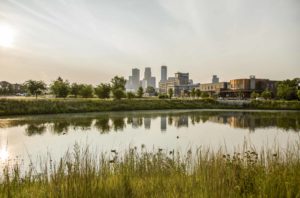
A restored pond buffer near downtown Minneapolis.
Why are Native Plants Better for the Environment?
Urban native landscapes are gaining more attention as the importance of sustainable land management becomes increasingly recognized. Native plants, which are adapted to the local climate and soil, can provide numerous benefits to urban ecosystems. One of the primary advantages of using local origin plants is that they require minimal inputs such as water and fertilizers. This makes them a low-maintenance and cost-effective option for urban landscaping. Additionally, native plants play an important role in supporting local wildlife, providing food and habitat for birds, butterflies, bees, and other pollinators. They are also more resilient in extreme weather, such as drought and flooding, because they are adapted to the local climate. This can help reduce the risk of damage to urban landscapes caused by extreme weather events. Further, native plants can help reduce runoff and erosion, as their extensive root systems help to stabilize soil.
Benefits of Urban Native Landscapes
Often overlooked are the variety of benefits which urban native landscapes can provide. They can increase biodiversity, reduce maintenance, and improve soil health. These plantings are adapted to the local climate and soil, so often require less water, fertilizers, and maintenance than non-native counterparts. This can save money for homeowners and businesses in the long run, once established. Additionally, native plants can add color, texture, and interest to a landscape. They attract beneficial insects, birds, and other wildlife to the urban environment. In certain cases, they can even help to break down pollutants in the soil. Foraging is another potential benefit of utilizing these types of landscapes. Many native plants can be eaten, when properly researched, identified, and prepared. Hazelnuts, berries, even roots have potential resource value.
Doug Tallamy, professor and author of Bringing Nature Home, discusses the benefits of changing how we think about our landscapes to benefit the environment. Using ecologically based landscapes can help to provide resources for wildlife now replaced by a monoculture of traditional turf, non-native plants, and pavement. His research and writings are valuable resources when considering how our landscapes can be better. And, his insights into how groups of plants that benefit many different species can be keystone ingredients into a landscape design. Species like oaks and goldenrods for example, become community anchors when attempting to create meaningful habitat. These species, in particular, host a plethora of beneficial wildlife.
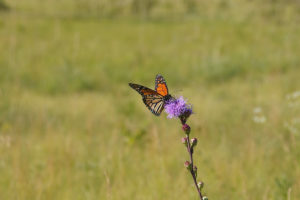
Monarch on Meadow Blazing Star
Steps to Design Native Plant Landscapes
Creating an urban native landscape can bring many benefits to cities and their inhabitants. Plant Native vegetation to create habitats for wildlife, reduce air and water pollution, and add beauty to an area. However, the success of a native landscape depends on how it is planned, planted, and maintained.
The first step is to develop a plan that takes into account the site’s shade, sun exposure, soil type, and water availability. These factors will help determine the best native plants to include in the landscape. It is important to research native plants suitable for the location and source them from local nurseries and growers. Plant the native species at the correct depth and spacing to ensure long-term success. Hiring a contractor, specialized in native plant landscapes, to design and install your planting can help to ensure success.
Once the landscape is planted, it is essential to maintain it properly. This includes providing adequate water, if needed, and making sure the planting is controlled for too much shading during its establishment. It is also important to keep an eye out for any invasive species that may begin to grow and to remove them while protecting the integrity of the installed plant material. Any necessary herbicides should be avoided during the initial year of growth. Here, again, a contractor who specializes in native landscapes can aid in your success by knowing which species to keep and which to remove.
Finally, it is important to monitor the health of the plants and soil, and to adjust the landscape design when necessary. By following these steps, urban native landscapes can be successfully created and maintained. This resulting in a variety of benefits to their communities.
Other Benefits of Urban Native Landscapes? Cost Savings
The use of urban native landscapes can be beneficial in many ways, particularly in terms of reducing costs associated with maintaining a landscape. These landscape types require less inputs, which can save a significant amount of money over time. Native landscapes will also help to reduce stormwater runoff and associated costs, as they are able to absorb more water than other types of landscapes. They can help to reduce soil erosion and soil remediation costs. This is because native plants tend to have deeper roots that help to hold the soil in place, preventing it from washing away. Additionally, native landscapes can help to increase biodiversity, which can reduce the need for costly pest control. Overall, the use of urban native landscapes can help to save money in the long-term, as well as helping to improve the environment.
We Can’t Just Let It Grow Wild
While the benefits of urban native landscapes are substantial, simply allowing a landscape to “return to nature” isn’t going to produce the outcome one might expect. Native plant communities are more rare than most assume, and also heavily fragmented. Combined with the pressures of numerous introduced species, in many cases the opportunity for native plants to naturally re-establish is minimal. As such, we need to create these spaces with a knowledge of how these plants participate in the ecology of their natural landscape. Selecting appropriate species allows us to encourage successful reintroduction of native species, while concurrently allowing for opportunities for human enjoyment at the same time. However, the impact of artificial forces like fragmentation and exotic species introductions must be overcome.
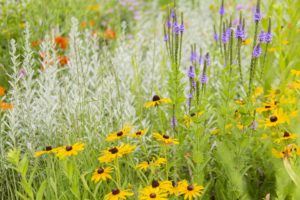
Prairie flowers properly selected for a site will be more successful.
It is Not Just the Trees
Native trees are important components of our urban landscapes. Not only do they provide shade, clean the air, and reduce they heat island effect, they also are resources for wildlife. Flowers benefit pollinators, fruits benefit birds and mammals, and caterpillars feast on leaves. However, we can’t ignore the ground layer by filling this area with an ecological desert of turf grass and ornamental plants. The ground layer is often where much of wildlife activity occurs. When deciding what should be placed down below, consider what ecosystem an area most resembles. Is it darker under a group of trees? Consider woodland plants. Is it sunnier? Perhaps, prairie plants are the answer. By thinking about more than trees, one will see a large increase in the kind of wildlife visitors their urban native landscape receives.
Got Milkweed?
Host plants are an essential, but often an under-focused part of a landscape plan. It’s easy to fixate on flowers and the visitors they attract. But just as important are how plants are beneficial to wildlife throughout their life cycle. Milkweed is a great example of this point. Monarch butterflies are highly desired visitor to gardens, often cited as an example for the benefits of urban native landscapes. Monarchs visit a variety of flowers as adult butterflies. However, in their caterpillar form they only consume milkweed. Without milkweed on the landscape Monarchs wouldn’t be present. So, by providing milkweed in our created ecosystems, we are supporting their reproduction and success. This relationship is not unique to Monarchs, and should be a consideration in our landscaping designs.
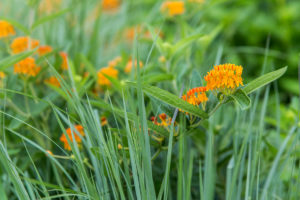
Butterflyweed (Asclepias tuberosa), a species of milkweed, blooms in bright orange.
Quick Tips for Sustainable Native Plant Landscape
- Provide native floral resources for pollinators like native bees and butterflies
- Choose a variety of species with bloom times that span the growing season for greatest impact
- Additionally, utilize host plants in the landscape. Milkweed for Monarch caterpillars, as an example
- Diversity supports diversity
- Provide vertical structure for cover/hiding places for birds and other wildlife
- Grasses and sedges in a matrix will give improved texture and keep weed pressure down
- Seeds and berries will be good resources for birds. But, insects are the primary way birds feed their young so their presence should be encouraged
- Pesticides may be a needed component in some cases, but their use should be responsibly and judicially utilized
Overall
The benefits of urban native landscapes are great. To realize these benefits, and to help these landscapes be appreciated by people as well as wildlife, care should be taken to choose the right plants for a location. Furthermore, informed maintenance activities will help to ensure the long-term health and aesthetics of any native landscape. With these conditions met, we can all create environmental landscapes that stitch together the habitat resources once naturally occurring in any area. Once anyone sees the benefits of urban native landscapes through the variety of wildlife their plantings attract, the value of such will be instantly realized.
Additional Resources
Landbridge Ecological Design Services
Audubon
Xerces Society
National Wildlife Federation
Minnesota DNR
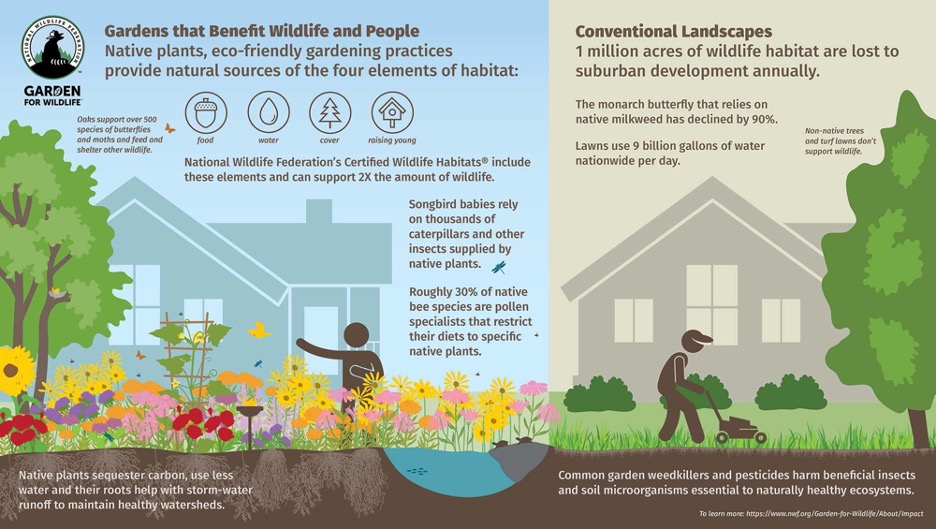
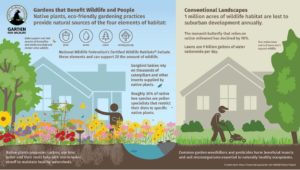
Recent Comments